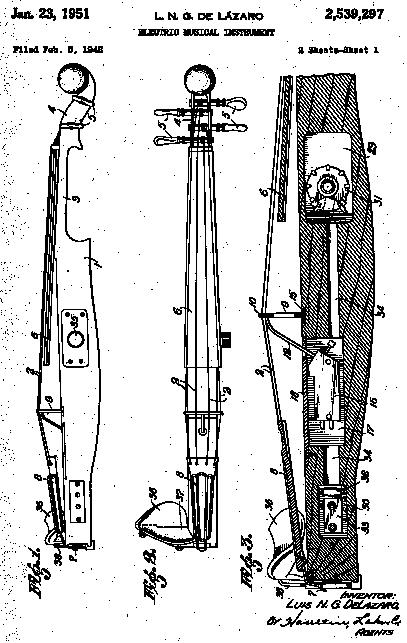Digital Violin
The Violin is Dead

Long Live the Violin
LUIS NICOLĂS GÓMEZ DE LÁZARO (1947)
UNITED STATES PATENT OFFICE (2,539,297)
ELECTRIC MUSICAL INSTRUMENT
Santander, Spain
Application February 5, 1948, Serial No. 6,530 - In Spain February 27, 1947
Patented Jan. 23, 1951
My invention relates to musical stringed instruments in which the vibrations of the strings are amplified by electrical means instead of using the sound box of ordinary instruments. The invention may be applied, to any type of musical instrument in which the sound is produced through the vibrations of one or more strings, but for the sake of greater clearness and to make it easier to understand the invention is described as applied to any instrument of the violin type, it being understood, however, that this reference to a violin is solely for the purpose of the description of the invention and does not constitute any kind of limitation of the possibilities or extent of the invention, which, as has already been stated above, is capable, of application to all, kinds of musical string instruments in general.
The primordial object of this invention is to obtain a musical stringed instrument capable of producing a pure and clear sound comparable to the sound of the most celebrated instruments of antiquity.
Another object of the invention is to provide a stringed instrument capable of producing a sound sufficiently powerful to accompany large jazz orchestras where the sound of a violin or ordinary stringed instrument is to all intents and purposes annulled.
Another object of the invention is to obtain a stringed instrument of the electric type, of very simple construction, resistant and easy to handle and that will, at the same time allow the violinist to easily graduate at will and within very extensive limits the intensity or modulation of the sound produced.
Another object of the invention is to provide a stringed instrument of the electric type that, should a breakdown occur in the electric part will be capable of easy repair by substituting in a very short time the damaged part by another.
The violin or other electric musical instrument constituting the object of this invention affords the musician, moreover, a great facility in its management or handling and apart from the fact that it is lighter and less voluminous than the ordinary instruments, it offers the advantage that the method of playing is exactly the same as with the ordinary instruments and, therefore, the player has no difficulty in handling this instrument nor does he need any special study, but can play this instrument exactly in the same way as an ordinary instrument, and has not to bother himself in the least about the electrical part, with the sole exception of graduating the intensity of the sound produced.
...
In connection with these figures that represent a preferable form of carrying out or adapting the invention, it will be seen that the violin has, externally, an appearance similar to that of ordinary violins, with the sole difference that it does not contain the usual sound-box.
The body of the violin is formed by a bar of wood or of some other material to form, as it were, the central stem of the instrument and that is not necessarily of greater width than that necessary to hold the strings. The body forms, at one of its ends the neck, as in the ordinary violins, and the tuning-head provided with the keys or pegs for tensioning and fixing the strings.
At a point half-way along the body of the violin the bridge is placed, on which the strings rest. This bridge … is constituted by a metallic piece the upper-arched edge of which has four small cuts or grooves to fix the position of the four strings of the violin, and from this edge extends a rod that is soldered or rigidly attached in some other way to the metal edge of the bridge, to transmit the vibration to a quartz. pickup, placed in a cavity of the body of the violin.
In this way the vibrations of the strings are transmitted to the metallic bridge and, through the rod they are transmitted to the- crystal pick-up
...
The absence of a resonator box in this violin has the further advantage of facilitating its use, for, in the ordinary violins with a resonator box there are certain moments in which the resonator box hampers the position of the violinist’s left hand, whilst in the violin of my invention this inconvenience does not exist and the left hand is always able to maintain a natural position.
As will be seen from the foregoing, my invention provides an electric violin, and, in general, an electrical stringed musical instrument of an exceedingly simple and robust construction, little liable to breakdowns, and which, should such a breakdown occur, can easily be repaired, for it is sufficient to lift the lid of the cavity in which the damaged part is situated and substitute another piece for it.

This work is licensed under a Creative Commons Attribution-NonCommercial-NoDerivs 2.5 License.
up


